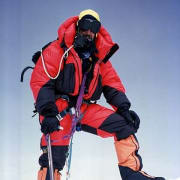The Cascade Volcanic Arc Features Mt. Baker

Mt. Baker (Koma Kulshan)
One of the snowiest places on earth can be found in the North Cascades just outside of Bellingham, Washington. Mt. back is an active stratovolcano part of the Cascade Volcanic Arc, or ‘Pacific Ring of Fire’, a series of volcanoes that includes Mount St. Helens, Mt. Adams, and prominent Mt. Rainier. Mt. Baker, known as Koma Kulshan to the Native American tribes of the Pacific Northwest, rises to an elevation of 10,781 ft. (3,286 meters). It is the third-highest mountain in the state, and the second most glaciated mountain in the lower-48 states. Only Mt. Rainier boasts more glacier terrain in the US beyond the mountains of Alaska. Koma Kulshan last erupted in the mid-19th century, although it remains ready to blow with ongoing geothermal activity.
While Mt. Baker doesn’t receive the attention of its big brother Mt. Rainier, though it is renowned for its impressive glacial landscapes, featuring ten significant glaciers. The Coleman Glacier on the northwest flank is particularly well-known among climbers and adventurers. These glaciers contribute to the surrounding river systems, including the Nooksack and Baker rivers, which are vital to the region's ecology.
The mountain is a popular winter destination for outdoor adventurers, including winter climbers, skiers and snowboarders. The Mt. Baker Ski Area receives substantial snowfall, often breaking records for the most snowfall in a single season in the United States. in 1999, the ski resort set the world record for recorded snowfall in a single season—1,140 inches. The summer months attract hikers, mountain bikers, and mountaineers who seek the challenge of its rugged terrain and spectacular views of the Cascade Mountains, Olympic Mountains, Puget Sound and the San Juan Islands.
Climbing Mt. Baker
Mt. Baker is required climbing for Pacific Northwest mountaineers, as are Mt. Adams and Mt. Rainier. Known for its technical glacial terrain and steep, icy conditions, the climb is challenging and requires proper physical conditioning and basic mountaineering skills. I recently climbed the popular Coleman-Deming Route on Baker. This route is relatively straightforward for experienced climbers, and a great first-climb for novice mountaineers.
Our team’s journey began at the Heliotrope Ridge Trailhead, located at around 3,700 feet (1,128 meters). We climbed among classic Pacific Northwest trees and waterfalls before reaching the alpine zone, where the terrain opens to reveal sweeping views of the surrounding North Cascades. As we progressed above the snowfield, we navigated the Coleman Glacier, where we had to navigate crevasses and icefalls. Proper gear, including crampons, ice axes, and ropes, is essential for safely traversing this icy expanse.
After crossing the glacier, we tackled the steep ascent to the saddle between Mount Baker’s two main summits. From there, the final push to the true summit at 10,781 feet (3,286 meters) involves negotiating icy sections, and a final steep headwall – the most challenging section on the mountain. The weather changed rapidly on our climb, so climbers should be prepared for cold, wind, ice and limited visibility on the final push to the summit.
Please note, Climbing Mt. Baker requires excellent physical fitness, technical mountaineering skills, and careful planning. If you are just beginning your climbing career, I recommend using a mountaineering guiding company, such as North Cascade Mountain Guides, or joining a team of experienced climbers.
